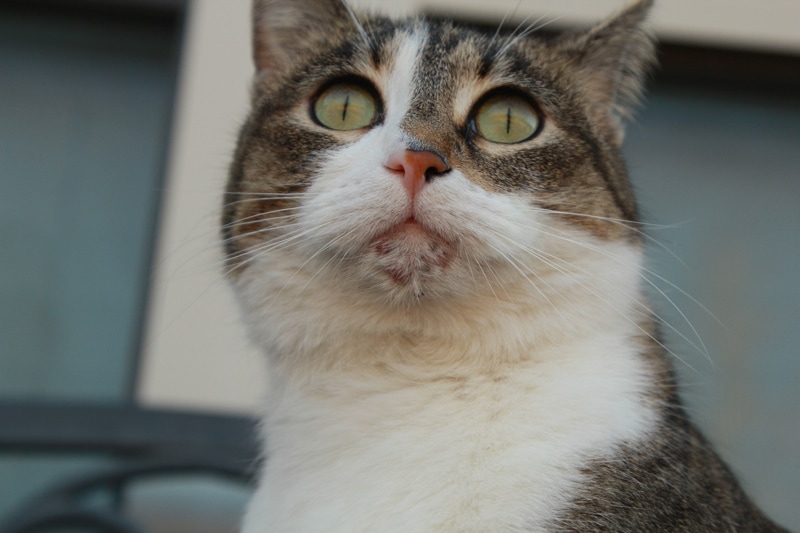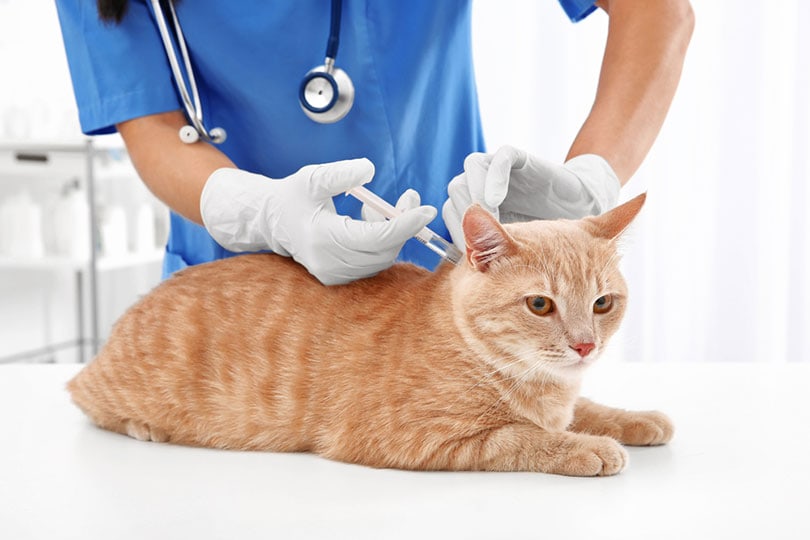
The word “mange” is a broad term that describes a parasitic mite that infects the skin of its host. Various mite species can infect all different kinds of animals, including cats. Depending on the mite, these can all vary in how they look, behave, and where they affect our feline friends. Generally, mange will affect cats by causing itchiness, redness, hair loss, crusting, or scales.
In this article, we’ll focus on how mange presents on a cat, how it is diagnosed, and some identifying factors amongst various types of mites.
Signs of Mange
Generally speaking, a cat that has mange will often be itchy and may have a rash or hair loss in specific areas. There can also be crusting or scales present on the skin, and sometimes dark brown ear exudate may be visible in the ears. This is all variable depending on which mite species is present, the parasitic load, how long the infestation has been going on, as well as how severely your individual cat is affected—since some can be more or less sensitive to the parasite.

How Is Mange Diagnosed?
A veterinarian will begin by getting a complete history and conducting a full physical exam of your cat. For those mite species that are visible to the naked eye or with a magnifying glass, they may be able to be identified relatively easily if seen. Often, a skin scrape (taking a sample of skin and preparing it on a slide to look at under a microscope), ear cytology (sample of ear discharge to look at under a microscope), and/or hair acetate preparation (hair held on a piece of tape to look at under the microscope) can confirm a diagnosis.
Sometimes, even if present on the cat, the mite may not be on the samples collected. In this case, taking many factors into consideration, a therapeutic trial may be warranted with the hope of a good response to treatment. Other tests such as a fecal test, dermatophyte (ringworm) testing, or a skin or ear sample for a culture and sensitivity test may also be needed to rule in or out additional possible diagnoses and to find the best course of treatment. Your veterinarian may also want to rule out other causes of itchiness, such as flea allergies.
The 7 Types Of Mites That Can Affect Cats
1. Canine Scabies (also known as Sarcoptic Mange)
This very contagious mite is typically present in dogs but can affect other species, including cats, that come into contact with the affected dog. The mites, called Sarcoptes scabiei var canis, are circular in shape with four pairs of short legs. Many times, an infected animal will be very itchy and often there will be a thick yellow crust, redness, and hair loss. At first, the lesions will start on the underside of the belly, chest, ears, elbows, and ankles and, if not treated, can spread across the body.
2. Notoedric Mange (also known as Feline Scabies)
Notoedric Mange is due to the mite species Notoedres cati. This is a rarer, yet contagious mite that burrows through the affected cat’s skin and results in an intense itch. If present in a cat, one would see yellow-gray crusts and hair loss most often on the ears, head, and neck that may later progress across the body. There may be thick skin and secondary skin lesions due to self-mutilation resulting from intense itching. Enlarged lymph nodes throughout the body can also occur. The mite itself looks similar to the canine scabies mite except that it is smaller in size.

3. Otodectic Mange (also known as ear mites)
Otodectic Mange is a fairly common cause of ear infections in cats, especially in young kittens, due to the Otodectes cynotis mite. These parasites most often affect the ear canal but can also occur around the ears, on the face, and occasionally across the body. The mites, while small, can sometimes be visualized and are seen on microscopic exams. An affected cat will often have frequent head shaking and ever-present ear scratching. There is typically a dark brown discharge located in the ear canal with thick, dark-colored crusts on the outside of the ear. Abrasions on and around the ears are common due to it being very itchy.
4. Feline Demodicosis
This is an uncommon skin disease in cats that can be caused by different species of demodectic mites including Demodex cati and Demodex gatoi. Visually, these mites are cigar-shaped but D. gatoi is shorter with a more broad, round abdomen than D. cati. Demodex infections can either be localized (often around the head and neck) or more generalized across the body. Often signs seen with Demodex infestation include alopecia, crusting, and secondary skin infections—sometimes there may be brown ear discharge present as well. Typically, D. cati mites don’t bother healthy cats but tend to be more of a problem if the host cat has another underlying illness such as a metabolic or immunosuppressive disease (ex: diabetes, FIV, cancer, etc). Cats with D. gatoi are considered contagious, and typically they experience an itchier response when compared to D. cati.

5. Cheyletiellosis (also known as Walking Dandruff)
The specific species that primarily causes Cheyloetiellosis in cats is known as Cheyletiella blakei, but there can be cross-contamination from other species. The “Walking Dandruff” moniker comes from the fact that it looks like small white flecks that can move around. These mites are very contagious and live on the skin’s surface. Physically, they have 4 pairs of legs and specifically identifying “hook-like mouthparts”. Clinically, a cat affected by these parasites will have scaling along the back that can also include crusting or miliary dermatitis (numerous small bumps often with crusting) throughout. There may be variable itchiness that can span from absent to severe.
6. Trombiculosis (also known as chiggers)
The two species that can affect cats are Neotrombicula autumnalis and Eutrombicula alfreddugesi. These non-contagious mites are a reddish-orange color, are oval in shape, and have 6 legs. They live outside on rotting organic matter, and the larvae can attach themselves to any cat that may brush against them. In temperate areas, these mites are typically active in summer and fall, and in warmer areas, they are active at various times throughout the year. A cat that is infested with this mite will usually have them cluster on the head, ears, feet, or underside of its belly. Lesions seen clinically will include hair loss, small pimple-like bumps, crusting of the skin, and redness. A cat can vary in their reaction to the mite from no reaction to very severe.

7. Lynxacariasis
Lynxacariasis is caused by a fur mite species called Lynxacarus radovskyi. It is currently present only in specific geographic regions and has only been reported in cats. Visually, these mites are tan in color, have a more flat-shaped appearance, and are present on the cat’s hair. Cats that are affected will have a dry, dull hair coat that can have a “salt-and-pepper” appearance. The host cat’s itchiness and hair loss can be variable, and gastrointestinal signs such as vomiting or diarrhea may also be present. It is thought that cats get the mite by being in direct contact with other cats that have them, but fomites (inanimate objects that carry and spread the infectious agent) may also play a role.
Can I Get Mange from My Cat?
Depending on the type of mite, yes, you can! Several of the species mentioned above are zoonotic, which means that the illness or affliction can spread from animals to people or vice versa. Zoonotic mite species discussed in this article include Sarcoptic Mange (Canine Scabies), Notoedric Mange (Feline Scabies), Otodectic Mange (Ear Mites), Trombiculosis (chiggers), and Cheyletiellosis (Walking Dandruff). If your cat is diagnosed with a zoonotic mite species, discuss your potential risk with your physician, any signs seen, and if needed, the best course of treatment options for you.
Mange Treatment
The good news is that if your cat is diagnosed with mites, there are treatment options! Determining which mite is present will dictate the specific course, but can include topical medications (such as spot-on treatments, sprays, ear cleaners, and medicated shampoos/baths), injectable drugs, and/or systemic oral drugs. Secondary skin infections can be common and if present, will need additional treatment, such as antibiotics or other topical medicated wipes or shampoos.
When mites are detected, other pets in the household may need to be treated at the same time. The environment could also need to be evaluated so as not to reinfect your cat. Your veterinarian will help you develop a plan to get rid of the mites which can encompass discussing specific medication instructions for each pet, their potential side effects, and environmental treatment and prevention.

Summary
Mange (i.e. mite infection) on a cat can present differently depending on the species of mite, but they often affect cats by causing itchiness, redness, hair loss, crusting, or scales. In addition to causing your cat discomfort, many can also be spread to other animals or people. If you see some of the signs discussed or have cause for concern, contact your cat’s veterinarian as soon as possible for the best outcome!
Featured Image Credit: Yaya Photos, Shutterstock








